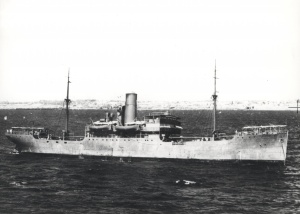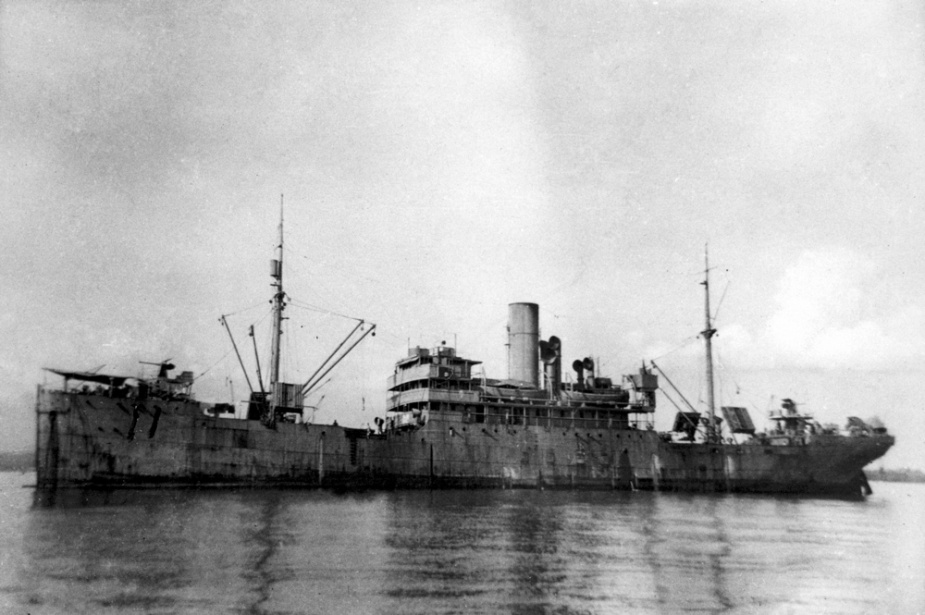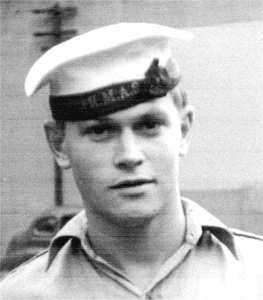HMAS Poyang
| Class |
Steam Ship |
|---|---|
| Type |
Armament Stores Issuing Ship |
| Pennant |
PY |
| Builder |
Taikoo Docks and Engineering Company, Hong Kong |
| Commissioned |
6 May 1943 |
| Decommissioned |
6 March 1946 |
| Fate |
Handed over to the British Ministry of War and Transport, and then returned to her owners |
| Dimensions & Displacement | |
| Displacement | 2873 tons |
| Length | 298 feet |
| Beam | 44 feet |
| Draught | 17 feet 6 inches |
| Performance | |
| Speed |
|
| Capacity | 4139 tons cargo |
| Propulsion | |
| Machinery | Single screw triple expansion, 175 NHP |
| Armament | |
| Guns |
|
The cargo steamer SS Poyang was built in Hong Kong in 1941 for the China Navigation Company. She departed Hong Kong for Australia before the Japanese entry to the war arriving in Broome on 19 December 1941 before heading on to Melbourne. There she was requisitioned for naval service on 12 May 1942 and fitted out as an Armament Stores Issuing Ship, keeping her civilian crew. A four-inch gun was fitted to her stern, which was manned by ten RAN gunners from the Defensively Equipped Merchant Ships (DEMS) section. She, along with another requisitioned Chinese steamer, SS Yunnan, began operating primarily off the Australian east coast and making occasional voyages to New Caledonia and New Guinea to re-ammunition Allied ships there.
In mid-1943 while at Milne Bay, New Guinea, Poyang’s Chinese crew refused to continue their work. Consequently, after all remaining embarked ammunition was unloaded, Poyang returned to Australia where the civilian crew was paid off and the DEMS sailors posted elsewhere. The ship was then refitted by the Adelaide Steamship Company Limited which equipped Poyang with the addition of a 3-inch gun, a 12-pounder high angle gun forward and two Oerlikon guns fitted amidships. Alterations were also made to engineering spaces and living quarters although conditions below deck left much to be desired; ventilation was poor and most sailors resorted to living on deck in hot weather.
HMAS Poyang commissioned in Sydney as a tender to the shore establishment HMAS Penguin on 6 December 1943 with Lieutenant John Edwards, RANVR, in command. The fitting out program continued after commissioning with ammunition and general stores bound for New Guinea being embarked at the same time.
Poyang put to sea for the first time as an RAN vessel on New Year’s Day 1944. Gun trials followed before the ship departed Sydney for Caloundra two days later. Due to a combination of factors, including engine defects which plagued the ship throughout her commission, Poyang was not able to rendezvous with the convoy at Caloundra with which she was meant to travel to New Guinea. She instead joined another convoy in Townsville on 17 January and arrived at Milne Bay four days later.
The next few months were spent in New Guinea waters supplying ammunition to Allied vessels, including the ammunition which had been off-loaded from Poyang the previous year that prompted the ship return to Australia. It was difficult and tiring work for the crew in the heat of the tropics, and the explosive nature of Poyang’s cargo often meant that she was required to anchor well away from other ships when in harbour. That, combined with the uncertainty of the ship’s movements, meant that time ashore for rest and relaxation was scarce and invitations to board other ships to watch a film were always warmly accepted.
Poyang spent much time in convoy during the year providing ammunition to Allied vessels in Task Forces 74 and 75. She was also part of the essential infrastructure which supported warships involved in the assaults on Japanese positions at places such as Aitape, Hollandia and Biak. As part of the Service Force Seventh Fleet - Leyte Gulf Unit, Poyang was also involved in the Leyte Gulf landings of October 1944.
Rough seas combined with the nature of Poyang’s operations transferring heavy materials on and off the ship, meant that damage to the ship’s superstructure was commonplace. Additionally engineering defects and coal shortages in New Guinea made it difficult for Poyang to maintain operations prompting the then Deputy Chief of Naval Staff, Commander Gatacre, DSC, to question why the ship was sent to New Guinea in the first place.
In November 1944 HMAS Yunnan arrived in New Guinea allowing Poyang to return to Australia. She arrived in Townsville on 29 December and continued on to Sydney the next day ending an 11-month deployment. On 16 January 1945 she underwent a further refit that saw alterations and improvements made to living quarters, coal bunkers, amenities and the depth charge workshop.
The refit completed on 26 March 1945 and, following a brief period of trials, Poyang returned to northern waters where she spent the remainder of the war in the New Guinea, Morotai and Indonesian areas. She arrived back in Milne Bay on 16 April and immediately recommenced the task of distributing ammunition. The need for ammunition diminished as the end of the war approached and Poyang spent the final weeks of the war in Morotai. She then returned to Australia arriving at Darwin on 17 September.
All remaining ammunition was off-loaded in Darwin and in its place stores were embarked to support Allied units preparing to occupy the island of Ambon. Poyang arrived in Ambon on 3 October and she remained in northern waters transporting stores, equipment and troops until 7 January 1946, when she returned to Sydney where she was stripped of all useful naval equipment and decommissioned on 6 March. She was then handed over to the Ministry of War Transport in August before being returned to her owners.





